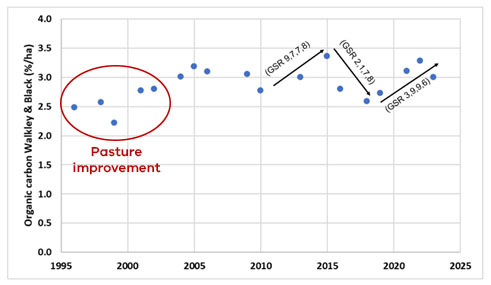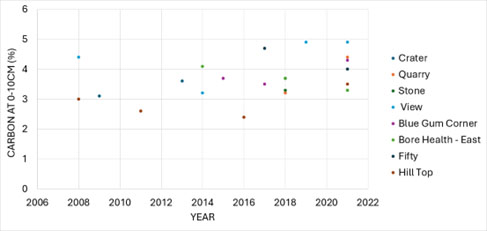Once it’s gone, it’s gone – your carbon?
Compiled by Jane Court with input and comments from Richard Eckard (University of Melbourne) and Cam Nicholson and Fiona Conroy (Knewleave Partnership)
Cam and Fiona have been investigating and monitoring the Carbon (C) on their farm for some time and have developed a clear understanding about C and emissions that are relevant to farmers. Paragraphs of their additional comments are preceded by 'CN/FC'.
How to use and manage the carbon in your soil
Livestock farmers are generally in a good position maintaining and building healthy carbon stocks in trees and soils. This is due to minimal soil disturbance compared to cropping, and the added value of trees in the landscape for livestock as shade and shelter. This carbon may appeal as a potential commodity; however, you should be aware that if you do sell it – it’s gone for someone else to use and you can’t double dip and use it yourself.
CN/FC: If you sell carbon you are then responsible for managing your land to look after that carbon for someone else. It needs to be maintained so it stays there for the permanency period. There can be implications if you change enterprises (e.g. go back to cropping after a pasture phase). This also raises potential intergenerational and sales risk.
While you retain the real benefits of healthy soils and tree plantations (which should be the main drivers), you would not to be able to use the carbon sequestered for your own carbon accounting. This is becoming more highly desired from supply chains and some banks. Even so, there are other important considerations in the complexity – the measurement and the ability to control or manage this carbon – before considering entering any market.
1. Accurate measurement of soil and tree carbon is difficult and expensive
There are simple models for estimating tree sequestration. Carbon calculators such as the SB-GAF tools and others that have been adapted from these (e.g. MLA calculator) use a simplification from the FullCam Model, using
tree area, age and region. The estimates can be very conservative but may also overestimate in some cases. You can pay consultants to measure your trees for you if you think this is the case, but it is expensive and there is the risk of being disappointed. A link to a video with Hugh
Stewart (Forestry scientist) and Graeme Anderson (Climate specialist, Agriculture Victoria) that walks through the various resources for estimating tree C sequestration, is provided in the reference list.
Similarly, getting accurate measure of soil C requires strict protocols and measurement over time given the variation across paddocks/soil types and time.
CN/FC: It is currently expensive and even these methods return a high degree of variability even in long term, undisturbed and well fertilised perennial pastures – see our soil C results in Figure 1.
A guide to these protocols can be found at: Soil carbon measurement practices required for carbon accounting in carbon farming projects – ‘Estimating soil organic carbon sequestration using measurement and model method’ Australian Government Clean Energy Regulator’s methodology for soil sampling guidelines.
2. Potential stocks – where you are and how high can you go?
For trees there will be a limit to how much you can plant on your farm with or without impacting on farm productivity. Generally, trees will peak in sequestration rates after about 10 years. They will keep sequestering after this but at much lower rates until they plateau. You may have heard recent interviews with Mark Wootten from Jigsaw Farms (links in reference list) who has been at the forefront of carbon-neutral farming with significant tree plantations (17% of the farm). This gave them 11 years of carbon neutrality. Trees don’t give C neutrality forever, but provide short-term wins and long-term farm and livestock benefits.
Although soil is a huge store of carbon globally, the potential to make significant long-term changes in pasture-based agriculture systems is not as easy as we might think. Large-scale Australian research conducted between 2012 and 2016 collected information on soil carbon stocks, including the potential of agricultural soils to store additional carbon, the rate that soils can accumulate C, the permanence and how to measure. (Soil Carbon Research Program SCaRP).
In Victoria, stocks of C were measured at 615 sites in pasture and cropping systems, encompassing 8 regions. The results showed an extremely wide range in SOC (soil organic carbon), from 2 to 239 t C/ha (at 0–30 cm). Almost 80% of the variation in SOC stock was related to annual rainfall or vapour pressure deficit (humidity). Texture-related soil properties accounted for a small, additional amount of variation (e.g. clay soils can hold more C than sandy soils).
Management practices had a minor influence (Fiona Robertson et al, 2016). Pastures that have been relatively stable in management are most likely at or close to optimum and have limited potential to grow. It will jump around from year to year. This has been found to be closely related to seasonal conditions and it would be unwise to commit to any significant and long-term change without good research and measurements.
Figure 1 shows the changing soil organic carbon on Cam and Fiona’s farm from soil tests (0–10 cm), from 9 paddocks (118 ha) of similar soil type over 28 years.

CN/FC: There is a slight trend up over time, and the variation looks to be explained by improved pasture production in the early years from more perennial grasses, fertiliser, lime and grazing, to growing season rainfall (GSR) in later years.
CN/FC: The numbers beside GSR refer to the decile GSR of each year in the period. According to the Socrates soil carbon model, our max carbon (Leco) is about 3.9%. The values in the graph are Walkley-Black, but when we have compared Walkley-Black to Leco on the same soil samples our Leco is consistently about 0.3% in SOC higher. We believe our attainable soil carbon is about 3.6% on the Walkley-Black scale. Therefore, we are close to the upper limit.
Another similar example from Jigsaw farm that has also done multiple soil C testing over time (14 years), shows similar trend (Figure 2.).

For both tree and soil C stocks, floods, drought and fire can have large impacts – which are generally out of your control. Also, scientists have estimated that a future climate that is warmer and has more droughts will see loss of soil C (Viscerra et al 2024).
3. Offset vs insetting
The term offsetting has been widely used as companies/organisations buy carbon credits (or purchase land to plant trees for example) to offset their emissions, largely from energy use. If farmers sell their carbon storage for others to offset their emissions, these farmers will not be able to use this carbon to offset their own farm emissions – termed insetting.
Credible insetting still has obligations, permanency, auditing etc. We could look to inset some of our stuff now, but it comes at a cost. However, the market isn’t mature enough to recognise this cost with improved prices offered. Why create them when it just increases your cost? This will change but it’s not there yet. It’s also worth calculating your emissions before considering entering a carbon scheme (schemes with integrity only credit net sequestration i.e. sequestration less any increase in emissions anyway) that way you can understand just how much carbon you would need to offset. Do you really have a surplus to sell?
For livestock farmers, most greenhouse gas emissions are methane from sheep and cows. Carbon sequestrated in trees (and possibly soil) can be used to inset your emissions to reduce your farm net GHG balance. If you still own them, you can choose how or to what product to allocate them to, i.e. if you produce meat and wool, the carbon sequestered in any year can be allocated to the meat or wool or split between depending on what markets are paying a premium or providing market access.
Similarly there is some evidence that the property market may be starting to look at the C status of farmland and the growing pressure from speculators that will potentially distort markets. agrifutures.com.au/resource/the-influence-of-carbon- on-property-prices/
There are a number of carbon markets and not all have the same integrity. It is also worth mentioning the landholder usually wears the risk when it comes to selling carbon. If you commit to a project but then cannot meet your obligation, then credible schemes will require you to buy carbon on the open market to offset that obligation at some point in the future. At whatever the current carbon price is at the time.
The key message is therefore to do your homework, know what you’ve got and get good advice before entering into C markets. We have listed below some of the available resources.
Further reading and references
‘A farmer’s perspective – making sense of carbon and emissions’ – a webinar with Cam Nicholson and Fiona Conroy.
(Please scroll down to 2022, many other webinars and resources listed here).
Country Hour interview with Mark Wootten
Introduction to soil C (elearn)
Robertson F. et al. (2016) ‘Soil organic carbon in cropping and pasture systems of Victoria, Australia’
Selling carbon from trees and soils
Soil Carbon Snapshot ![]() [PDF File - 7.1 MB] Graeme Anderson, Melissa Cann and Heather Field, Agriculture Victoria (updated 2022). This booklet includes the latest science around soil carbon and links to 70 research references and soil carbon reports relevant for Australian agriculture.
[PDF File - 7.1 MB] Graeme Anderson, Melissa Cann and Heather Field, Agriculture Victoria (updated 2022). This booklet includes the latest science around soil carbon and links to 70 research references and soil carbon reports relevant for Australian agriculture.
Soil carbon measurement practices required for carbon accounting in carbon farming projects – ‘Estimating soil organic carbon sequestration using measurement and model method’ Australian Government Clean Energy Regulator’s methodology for soil sampling guidelines.
The Australian Ag Podcast Mark Wootton: Debunking the carbon myths. Over The Fence with Joe Briggs.
The Soil Carbon Research Program (SCaRP)
Trees and farming – perfect partners (YouTube video with Hugh Stewart and Graeme Anderson) and includes list of resources used (scroll to the bottom of the page)
The influence of carbon on property prices - Agrifutures video
R. A. Viscarra Rossel et al 2024 ‘A warming climate will make Australian soil a net emitter of atmospheric CO2’, Nature Portfolio Journal.